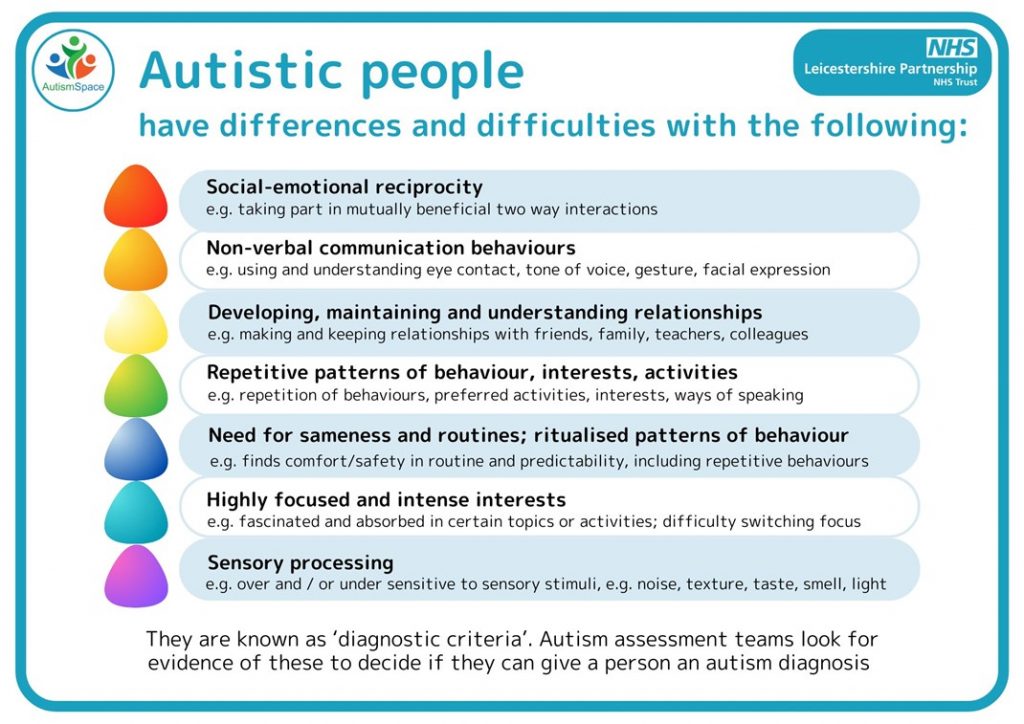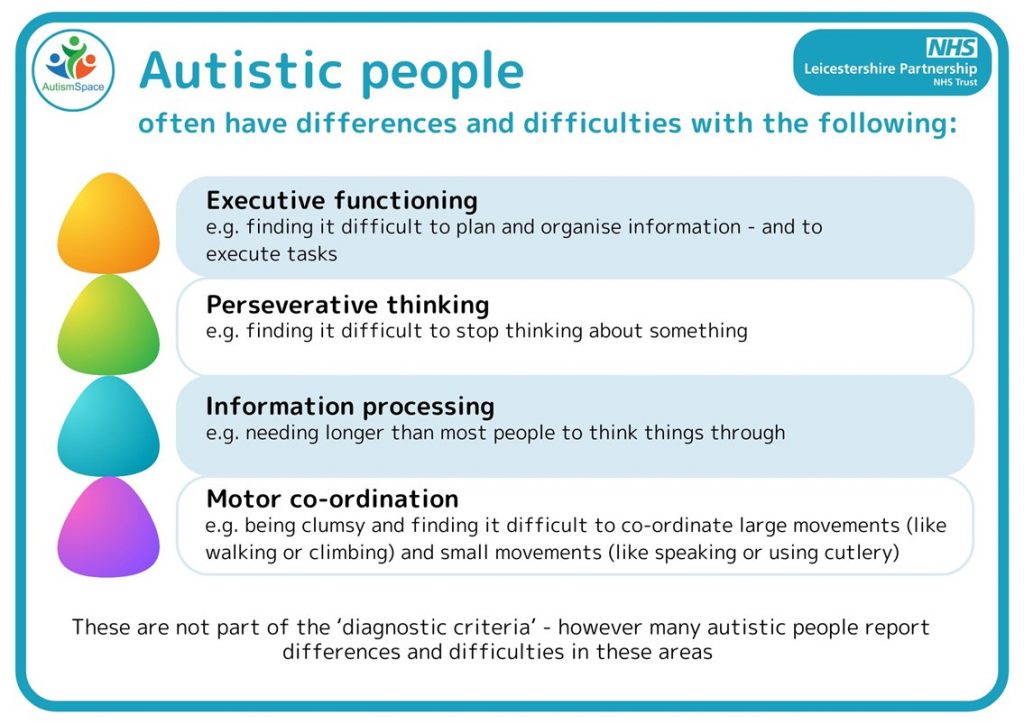Each has their own unique profile of communication style, behaviours, differences, difficulties, needs and strengths.
However, autistic people have similarities in their neurology and thinking styles, which can be generalised and broken down into categories.
This helps us understand how and why autistic people think and behave differently from most other people.
It also helps clinicians carry out autism assessments.
Autism diagnostic criteria
When a person of any age undergoes an autism assessment, the clinical team looks for certain behaviours particular to autistic people and different from neurotypical people. These differences in autistic behaviours are known as the ‘diagnostic criteria’ for autism.
The diagnostic criteria are divided into several areas. To be given an autism diagnosis, there needs to be evidence the person displays behavioural signs within each of these areas of difference, throughout their life so far.
Typically, the assessment should involve making observations of the autistic person, plus carrying out interviews with the autistic person and people who have known them well for a long time.
Social-emotional reciprocity
Differences in this area can cause challenges for autistic people when they have conversations and interactions with other people.
For example, sometimes it might be hard for them to be sure what the other person means or what the other person is thinking or feeling.
Sometimes the other person might struggle to understand clearly what the autistic person is trying to communicate.
Autistic people can also find it difficult to choose or change topics – or to take turns in the way that most other people expect.
Autistic people may appear to lack interest in others. They might even seem to be ‘in a world of their own’.
Autistic children may struggle to share or to play with other children – and may feel more comfortable playing alongside others instead.
Non-verbal communicative behaviours
Autistic people tend to have difficulty ‘reading’ most other people’s non-verbal behaviour, such as: eye contact, gesture, tone of voice, and facial expression.
Often their own non-verbal behaviour is different compared to most other people. They may for example lack variety in facial expressions or have a monotone voice. Or they may even be just the opposite and overly expressive with their voice, face, and gestures.
Because of this, other people can often misunderstand what autistic people mean – or what they are thinking and feeling.
Developing, maintaining, and understanding relationships
There are a number of reasons autistic people often have difficulties in this area.
Differences with social-emotional reciprocity plus verbal and non-verbal communication style can contribute to difficulties in getting along with other people.
For these reasons, autistic people can find it hard to make and keep friends and may find it challenging when it comes to their relationships with family members, teachers, or colleagues.
Autistic people often have interests that other people may struggle to share or appreciate. This can contribute to difficulties in fostering social connections.
It’s also quite common for autistic people to like spending a lot of time on their own. Plus, compared to neurotypical people, autistic people might not contact other people so often by phone or message. And autistic children might not tend to initiate play with others.
Despite these challenges, this does not mean autistic people don’t enjoy friendships. Some may find one-to-one interactions and friendships much easier than being in a group. Many autistic people enjoy the company of people who think and communicate in a similar way to them or who share similar interests. And it’s common for autistic people to have good friendships with other neurodivergent people.
Restricted, repetitive patterns of behaviour, interests, or activities – including stereotyped or repetitive motor movements, use of objects, or speech
This means that some autistic people are compelled to make repetitive movements – for example rocking their body, moving their hands or fingers or playing with an object in a repetitive way. This can be calming and satisfying – and is known as stimming. Click this link to find out more about stimming.
Some autistic people like to order objects or find it irritating when things are not in an order that makes sense to them.
Some autistic people repeat words or phrases (this is known as echolalia). They might like to listen to the same piece of music, read the same book or watch the same TV programme again and again. All these things can be satisfying and soothing.
Insistence on sameness, inflexible adherence to routines, or ritualised patterns of verbal or nonverbal behaviour
This means that autistic people often prefer things to be predictable. They tend to like doing things in the same way each time. For example, taking the same route to the shops, parking in the same spot, eating the same foods, wearing the same clothes every day, keeping their belongings in specific places.
They often prefer to have routines. They may get stressed if things do not happen in the way that they expect or in the way that they are used to.
Changes can be difficult – such as starting a new school or job, ending a relationship, the loss of a loved one or even going on holiday.
Highly restricted, fixated (intense) interests that are abnormal in intensity or focus
This means that by comparison to neurotypical people, autistic people often have interests or hobbies that seem unusual in some way. These might be ‘niche’ topics of interest. Or they might have quite typical topics of interest, but other people might judge them as being overly obsessed or fixated.
Autistic people often focus on their interests deeply and over a long period of time. They can become expert and knowledgeable about their areas of interest – and it’s common to find that they love to talk about them at length.
Many autistic people find that spending time on their interests is therapeutic – and that it really helps them to regulate their emotions and cope better with challenges. It can be difficult and stressful for autistic people to switch focus from their interests when other people expect them to.
For more information about autism in relation to hobbies and interests click here.
Sometimes autistic people can get very attached to certain objects or possessions, finding them comforting. This attachment may mean that they get distressed if for any reason they cannot have these objects.
Hyper- or hypo-reactivity to sensory input or unusual interest in sensory aspects of the environment
Sensory information includes sights, sounds, smells, tastes and touch. There are also internal senses called ‘interoception’, ‘proprioception’ and the vestibular system. For more information on this click this link.
Autistic people tend to process this sensory information differently from most other people. For example, they may be overly sensitive to certain sights, sounds or textures. This means that certain noises, clothes, foods or lighting might make them feel irritated or distressed.
Sometimes autistic people want or need sensory information more than most other people. For example, they might like to touch certain fabrics or listen to certain sounds. These things can be soothing or satisfying for them.
Also, it’s quite common for autistic people to struggle to notice and respond to internal sensory signals – for example they may not readily realise when they are hungry, thirsty, too hot or cold, need the loo or are in pain.
Similarly, they may struggle to recognise changes in their emotional state – which can then contribute to difficulties in expressing and regulating their emotions.
The way autistic people process sensory information varies from person to person and can also change from day to day or over time.
A point to note:
The diagnostic criteria were developed following research on a largely white, cis, male population – which may account for why autism is more frequently diagnosed in this population and less so in other marginalised populations such as women and girls and non-white people. For more information about this topic, click this link.
Additional autistic differences and difficulties
The features on the following list are not part of the autism diagnostic criteria, however they may be more common for autistic people, when compared to the general population:
Some autistic people may also have:
- A learning (intellectual) disability
- Another neurodevelopmental condition, such as:
- Attention Deficit Hyperactivity Disorder (ADHD)
- Dyspraxia (Developmental Co-ordination Disorder)
- Tics or Tourette’s
- Specific learning difficulties, such as:
- Dyslexia
- Dyscalculia
- Dysgraphia
- Prosopagnosia (‘face-blindness’)
- Hyperlexia
- Ehlers-Danlos syndrome (EDS)
- Post Orthotic Tachycardia Syndrome (POTS)
- Visual impairment
- Hearing impairment
- Neonatal encephalopathy or epileptic encephalopathy, including infantile spasms
- Epilepsy
- Chromosomal disorders such as Down’s syndrome
- Genetic disorders such as fragile X
- Muscular dystrophy
- Neurofibromatosis
- Tuberous sclerosis
- Fetal anti-convulsant syndrome
Please note this is not an exhaustive list.
For more information about autism and co-occurring conditions, click this link.
Sources and further reading
https://embrace-autism.com/decoding-autism-in-the-dsm-5/
https://www.autism.org.uk/advice-and-guidance/professional-practice/epilepsy-autism
Ehlers Danlos and Autism – Ehlers Danlos Awareness
Blitshteyn, S. Is postural orthostatic tachycardia syndrome (POTS) a central nervous system disorder?. J Neurol 269, 725–732 (2022)
Silberman, S. (2015). NeuroTribes: The legacy of autism and the future of neurodiversity. Avery.




